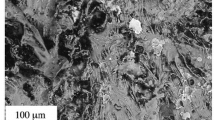Abstract
The concentration of ten chemical elements in the surface of a titanium alloy after grinding by a silicon-carbide wheel is determined by means of a Versa 3D twin-beam electron microscope. The content of C, N, O, and Si in a surface layer of up to 200 nm much exceeds the values permitted by the corresponding GOST State Standard. Silicon-carbide crystals are found in the ground surface.
Similar content being viewed by others
References
Sayutin, G.I. and Nosenko, V.A., Shlifovanie detalei iz splavov na osnove titana (Grinding of Titanium-Alloy Parts), Moscow: Mashinostroenie, 1987.
Nosenko, V.A., Shlifovanie adgezionno aktivnykh metallov (Grinding of Adhesive Metals), Moscow: Mashinostroenie, 2000.
Kragel’skii, I.V., Trenie i iznos (Friction and Wear), Moscow: Gos. Nauch.-Tekhn. Izd. Mashinostr. Lit., 1962.
Nosenko, V.A., Sayutin, G.I., and Bogomolov, N.I., Influence of the physicochemical interaction of the abrasive with the ground surface on the wheel wear, Fiz. Khim. Mekh. Mater., 1981, no. 1, pp. 110–111.
Sayutin, G.I. and Nosenko, V.A., Microchemical surface changes of titanium alloys in grinding, Tren. Iznos, 1983, vol. 4, no. 2, pp. 348–352.
Nosenko, V.A. and Sayutin, G.I., Influence of the activation energy on the transfer of silicon in the grinding of titanium alloy by a silicon-carbide wheel, Tren. Iznos, 1994, vol. 15, no. 4, pp. 713–715.
Gorbunov, B.I., Moiseev, V.Ya., and Stepanov, Yu.S., Surface charging with abrasive in centerless grinding of steel parts, Izv. Vyssh. Uchebn. Zaved., Mashinostr., 1984, no. 5, pp. 122–126.
Nosenko, V.A. and Kiselev, V.V., Influence of the chemical activity of fillers on the wear of a grinding wheel in machining metals of the titanium subgroup, Tekhn. Mashinostr., 1984, no. 5, pp. 122–126.
Nosenko, V.A., Improving abrasive tools with Bakelite binder, Probl. Mashinostr. Nadezhn. Mash., 2004, no. 3, pp. 85–90.
Kanaya, K. and Okayama, S., Penetration and energy loss theory of electrons in solid targets, J. Phys. D, 1972, no. 5, pp. 43–58.
Reed, S.J.B., Electron Probe Microanalysis and Scanning Electron Microscopy in Geology, Cambridge: Cambridge University Press, 2005
Termodinamicheskie svoistva neorganicheskikh veshchestv: Spravochnik (Thermodynamic Properties of Inorganic Materials: A Handbook), Zefirov, A.P., Ed., Moscow: Atomizdat, 1965.
Author information
Authors and Affiliations
Corresponding author
Additional information
Original Russian Text © S.V. Nosenko, V.A. Nosenko, A.A. Krutikova, L.L. Kremenetskii, 2015, published in STIN, 2015, No. 1, pp. 26–29.
About this article
Cite this article
Nosenko, S.V., Nosenko, V.A., Krutikova, A.A. et al. Surface-layer composition of titanium alloy after dry grinding by a silicon-carbide wheel. Russ. Engin. Res. 35, 554–557 (2015). https://doi.org/10.3103/S1068798X15070163
Published:
Issue Date:
DOI: https://doi.org/10.3103/S1068798X15070163



